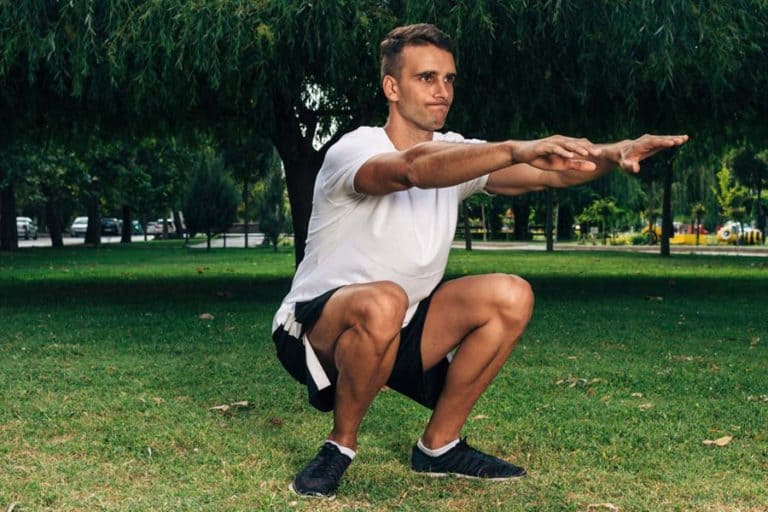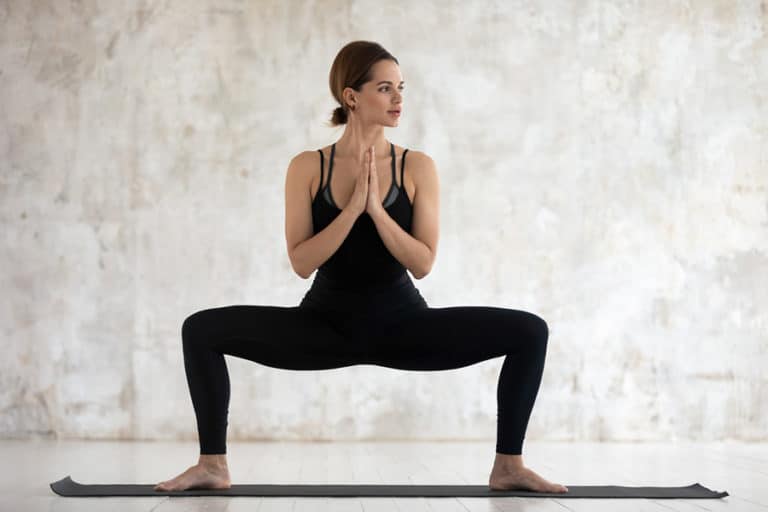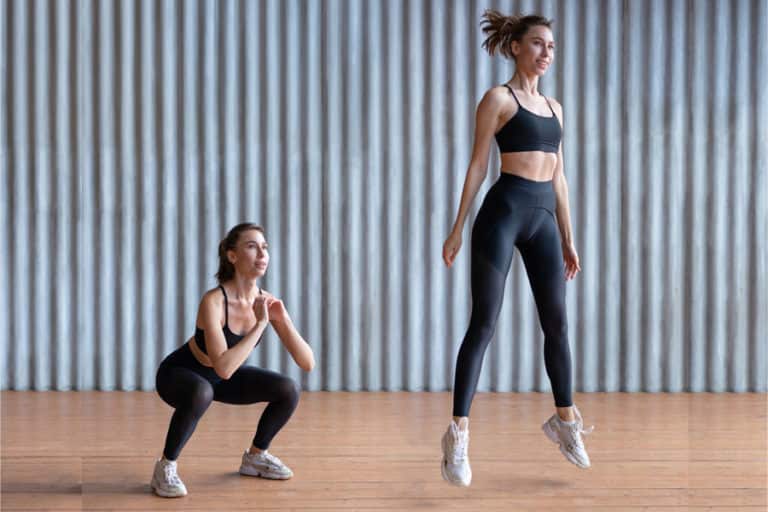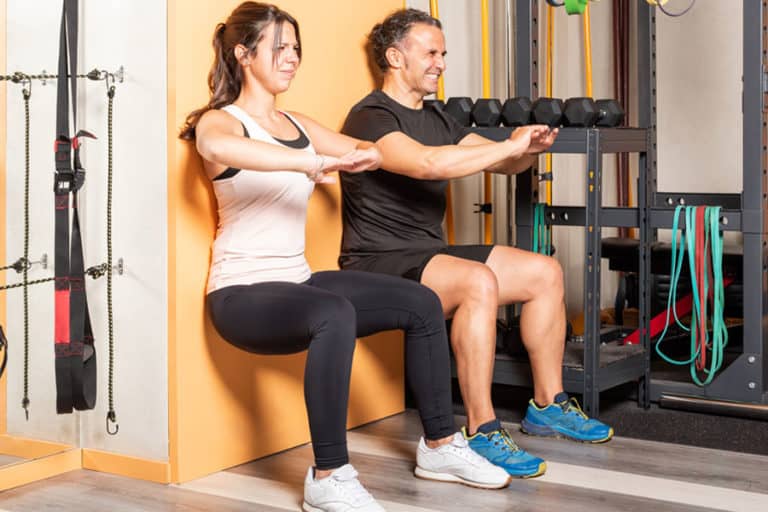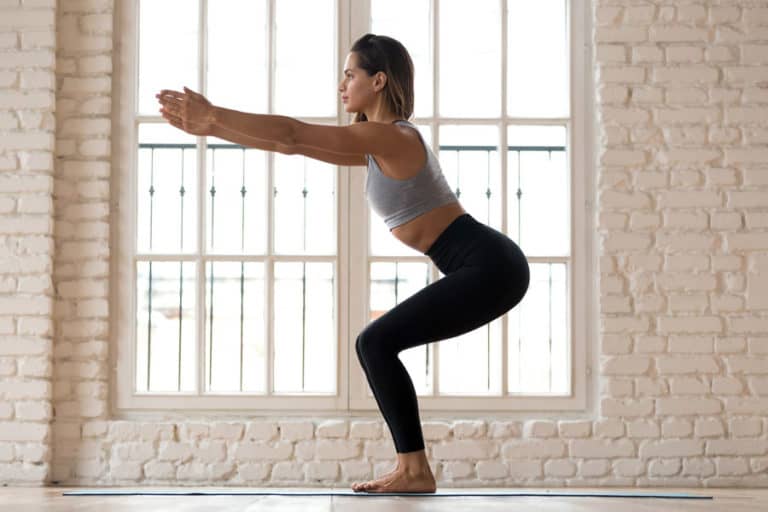Pistol Squats – 7 Step Progression, Technique, And Tips
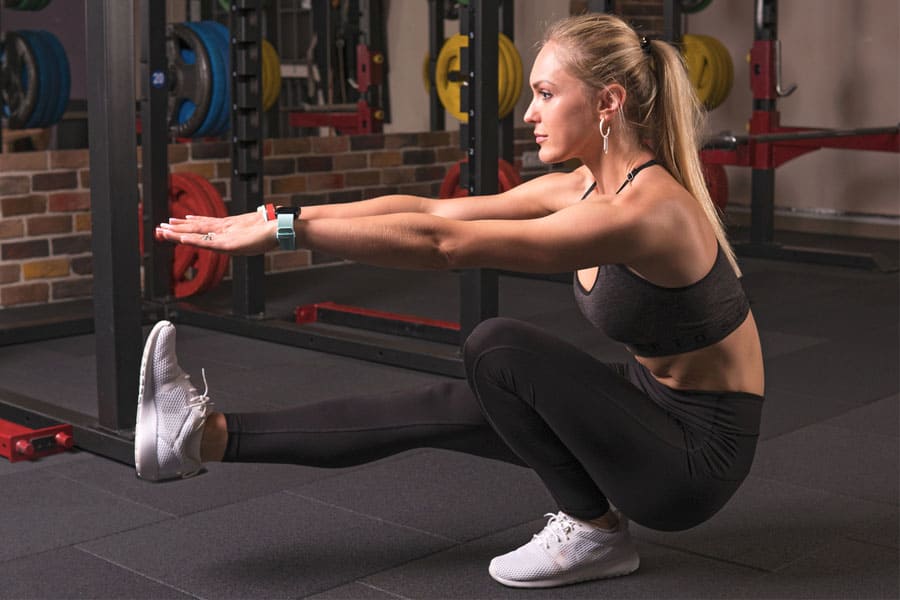
Definition | How to do | Muscles worked | Master the form | Add to routine | Safety tips | Benefits | FAQs
Pistol squat is an advanced, unilateral variant of squats. It is one of the most common additions to CrossFit training routines.
Since its movement is executed with just one leg, the pistol squat can be a very difficult bodyweight squat to master. A proper progression plan and carefully mastering the form are the keys to performing this challenging squat flawlessly.
What is a pistol squat?
A pistol squat is an advanced strength and flexibility exercise where the athlete stands on one foot and performs a deep, controlled squat. It requires a significant amount of balance, coordination, focus and strength.
How to do a pistol squat?
The pistol squat is a complex squat form that requires specific kinds of flexibilities, motor strengths, and balance. Below is a step-by-step split-up of these incredibly challenging squats. Read it carefully before you try performing this squat.
- Stand with your feet shoulder-width apart, toes pointed forward, and your chest tall and proud.
- Slowly extend your right leg straight ahead while balancing your body weight on the left leg.
- Now bend your left knee and lower your hips as far as you can. Simultaneously, extend both your arms straight ahead for balance.
- Pause at the bottom of the move and then push through your heels and rise to the starting position.
- Repeat this movement with the opposite leg.
Pistol squats muscles worked
Pistol squats are a compound exercise that targets multiple muscles in the posterior chain [1]USF Health: The posterior chain muscles, which include the lumbar extensors, gluteals, hamstrings, and calves, are crucial for performance, physique, injury prevention, and rehabilitation. These are the muscles that run along the back of your body and are vital for balance, posture, and injury prevention. Here is a list of the muscles targeted by pistol squats:
Primary Muscles
| Glutes | gluteus maximus, gluteus medius, gluteus minimus |
| Quadriceps | vastus medialis, vastus lateralis, rectus femoris, vastus intermedius |
Secondary Muscles
| Hamstrings | semitendinosus, biceps femoris, semimembranosus |
| Hip muscles | hip flexor muscles (psoas major, psoas minor, illiacus) |
| Core muscles | rectus abdominis, obliques, transverse abdominis, erector spinae |
| Knee Muscles | plantaris, popliteus |
| Calf muscles | gastrocnemius, soleus |
Pistol squat progression – To master the pistol squat form
Balancing your body weight on one foot while performing squats is both difficult and risky. We have chalked out a progression plan to help beginners learn the basics of pistol squat form and its range of motion.
Level 1: Basic squat
Perfect the basic squat form first. Elements that you need to master include:
- Maintaining a neutral spine
- Engaging the core
- Squatting to a parallel
- Driving through your heels during the bailout
Practicing basic squats will help you assess your current fitness levels, strengths, and weaknesses.
Level 2: Deep squat
The proper range of motion of the pistol squat requires you to lower your body as deep as possible. Ideally, you should descend all the way down until your butt touches your lower shins or heels. So, before you start practicing to squat on one leg, polish your deep squat skills.
Level 3: Negative pistol squat
The negative pistol squat is ideal for mastering the downward phase of pistol squats. In the negative pistol squat, you lift one leg and extend it out as you lower the hips, but keep it planted on the ground as you rise. Here is how the move looks:
- Assume the same starting position you would for basic squats.
- Extend one leg ahead and lower your hips.
- Once you reach the bottom, bring the extended foot back, place it on the floor, and rise back up.
- Repeat the same movement for the next rep.
Level 4: Assisted pistol squat
Beginners transitioning from basic squats to pistol squats will need to practice with some form of assistance or support. Practice the pistol squat, holding TRX straps. This will help beginners to execute the complete range of motion without risking falls, imbalances, or injuries.
Level 5: Pistol box squat
Box squats are an excellent way to perfect squat depth and increase confidence in performing squats. In this version of the pistol squat, you place a plyometric box behind you to break your descent.
Start with a box that will allow you to descend until your thighs are parallel to the ground. As you gain confidence, you can replace the box with a shorter one that will let you squat deeper.
Level 6: Pistol squat with counterweight
Using weights to practice a bodyweight exercise may sound illogical. However, a pistol goblet squat incorporates a weight (kettlebell or a dumbbell) that is held at chest level. This acts as a counterbalance making it easier and safer to perform the pistol squat.
Level 7: Normal pistol squat
Once you cross these progression levels, your range of motion, stance, and depth will be ready for the actual, unassisted pistol squat.
Adding pistol squats to your routine
Pistol squats are easy to adapt to your regular fitness routines. You can do them separately or incorporate them into your lower body fitness rotation/circuit.
Stand-alone circuit:
Always start with a few warm-up exercises to loosen up and activate your muscles.
Warm-up:
- Cardio (light jogs)
- Hip, knee, and ankle mobility exercises like hip hinges, ankle rocks, and assisted knee flexion.
Stand-alone pistol squat workout circuit based on fitness goals:
| Goal | Reps |
| Improving squat form | 2-3 sets of 5-10 reps on each side |
| Endurance building | 2-3 sets of 10-15 reps on each side |
| Muscle building (Hypertrophy) [2]National Academy of Sports Medicine: MUSCULAR HYPERTROPHY: BACK TO THE BASICS | 3-5 sets of 10-12 reps on each side |
Simple lower body workout plan with pistol squats:
Before getting into this exercise circuit warm up with some light cardio and gentle hip knee and ankle mobility exercises mentioned above.
| Exercise | Sets and reps |
| Step ups | 2-3 sets of 5-10 reps |
| Lateral lunges | 3-4 sets of 8-12 reps |
| Pistol squats | 2-3 sets of 10-15 reps |
| Reverse crunches | 3-5 sets of 8-10 reps |
| Cat cow pose (cool down stretch) | 1 – 2 minutes |
Safety tips
Pistol squat requires a considerable amount of strength and balance. This makes it one of the most complex squat formats. To ensure optimal effectiveness and physical safety, follow the safety tips provided below.
- Warm-ups and flexibility exercises are a must if you want to perform pistol squats effectively.
- Make sure that the downward phase of the move is executed slowly and with control.
- Hinge your hip during the downward phase. This will help to prevent your lower back from rounding.
- Drive through your heels during the upward phase of the squat. Your glutes and your heels should power your bailout motion.
- Don’t let your body lean forwards or round at the back. Both can have adverse effects on the lower back.
- Never rise before breaking past the parallel. Try to squat as deep as possible and complete the required range of motion.
- If you experience any pain during the exercise, stop immediately and seek medical help.
Pistol squats’ benefits
Stronger muscles and joints, better balance and coordination, and improved mobility are just some of the benefits that pistol squats can offer. Here are some of the major benefits of performing pistol squats:
- Being a unilateral exercise, the pistol squat reduces muscle imbalances in both legs.
- There is more mind-muscle connection [3]Arizona State University: The Mind-Muscle Connection while performing a single leg squat progression like the pistol squat resulting in better activation of all the muscles involved.
- As a complex, compound exercise, the pistol squat targets multiple muscle groups in the posterior chain. This translates into more strength in the entire back and leg region.
- The functional strength gained through this exercise improves the ability to perform both day-to-day activities and other forms of exercise.
- It increases balance and physical awareness (proprioception)[4]ResearchGate: Proprioception – Theory and Practical Applications.
- Pistol squats can lead to hypertrophy or the building of muscle mass. This happens due to the impact of eccentric activity [5]American Physiological Society: Adaptive responses to muscle lengthening and shortening in humans in the leg muscles.
- The core muscles are activated during the lowering of the hips as well as when maintaining balance in the extended leg. This makes the pistol squat an excellent exercise for developing core strength.
- Pistol squats can help improve your mobility, flexibility, and range of motion.
Conclusion
Pistol squats are an excellent exercise for developing strength, balance, and mobility. However, they are also quite challenging and require a lot of practice. Ideally, perform this exercise under the supervision of a certified personal trainer or a fitness coach. With proper form and technique, you can reap all the benefits that pistol squats have to offer.
FAQs
How impressive is a pistol squat?
A pistol squat is an impressive feat of strength and balance. It requires the lifter to perform a full-body, single-legged squat while standing on one foot and maintaining perfect form throughout the exercise.
Do pistol squats damage knees?
Pistol squats are a challenging exercise that can help to build strength and improve balance. However, if not done correctly, they can put excessive strain on the knees and cause damage. To avoid any knee-related issues, it’s important to perform pistol squats with proper form and technique. Additionally, those with existing knee conditions or previous injuries should take extra precautions when doing these exercises to avoid further harm.
Why are pistol squats so hard?
Pistol squats are an incredibly challenging exercise that requires strength, balance, and flexibility. They demand a great deal of control and coordination — you must be able to keep your body strong and steady while squatting down on one leg. They also involve plenty of hipwork, which can make them difficult for some people to master. The result is an intense workout that really taxes the whole lower body.
What should I do if I can’t do a pistol squat?
If you can’t do a pistol squat, you should start by mastering regular squats first. You may find it helpful to use assistance such as a broomstick or wall to help balance yourself while learning the proper form. Additionally, using mini bands across your thighs and feet can provide extra support and allow you to gradually increase the depth of your squat. Lastly, focusing on building up single-leg strength with exercises like Bulgarian split squats and Romanian deadlifts will also be beneficial in helping you achieve a perfect pistol squat.
References
| ↑1 | USF Health: The posterior chain muscles, which include the lumbar extensors, gluteals, hamstrings, and calves, are crucial for performance, physique, injury prevention, and rehabilitation |
|---|---|
| ↑2 | National Academy of Sports Medicine: MUSCULAR HYPERTROPHY: BACK TO THE BASICS |
| ↑3 | Arizona State University: The Mind-Muscle Connection |
| ↑4 | ResearchGate: Proprioception – Theory and Practical Applications |
| ↑5 | American Physiological Society: Adaptive responses to muscle lengthening and shortening in humans |


